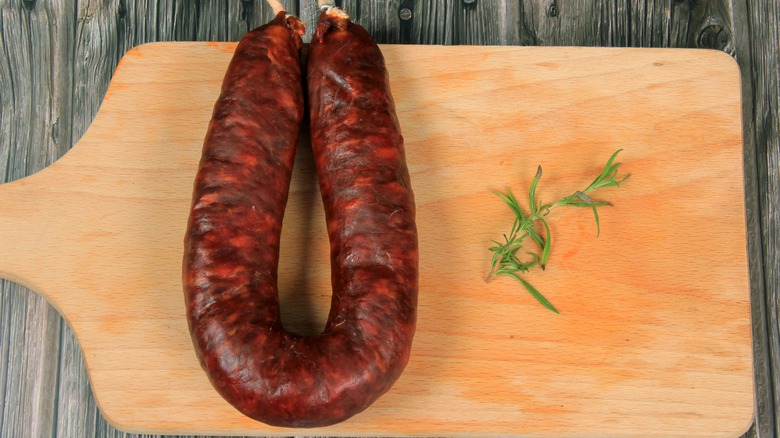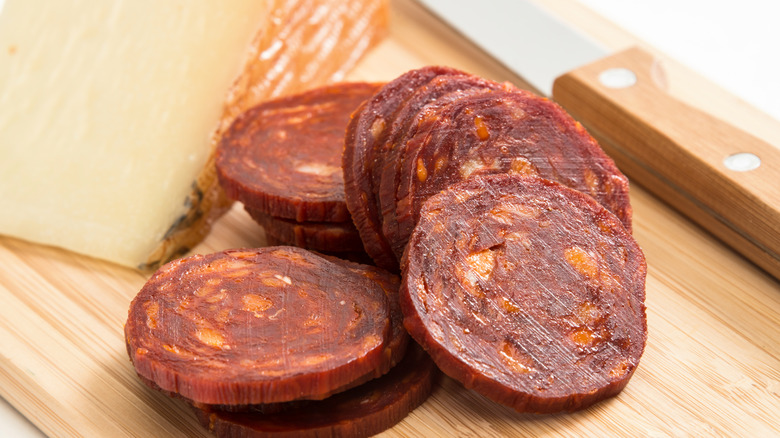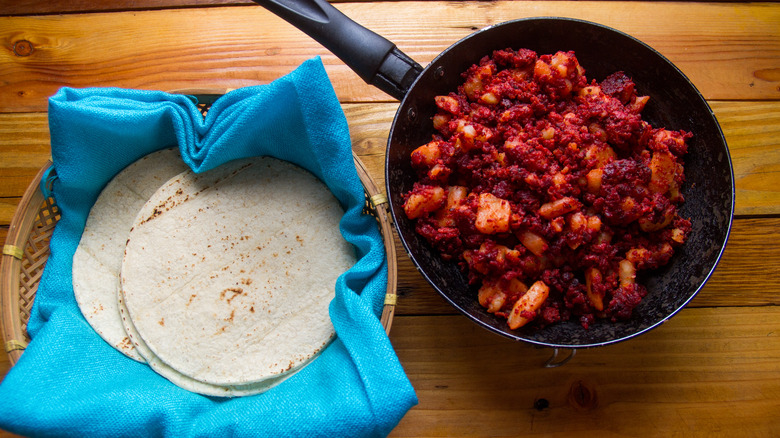The Differences Between Spanish And Mexican Chorizo
The world shares many things, one of which is an affinity for sausage. You can find sausage in most countries, each one defined by its own unique ingredients. Some of them even share a name, like chorizo. Chorizo is a type of sausage found in both Spanish and Mexican cuisine, and they likely share the moniker because the countries share a language — "chorizo" is the Spanish word for "sausage."
Neither Spanish nor Mexican chorizo existed before Spanish explorers came to the Americas. It would take elements from both Spain and the New World to create the foods that are now considered staples in their respective countries. Pork was a major food source in Spain, where it was often cured in order to preserve it.
The explorers brought pigs with them on their journeys across the Atlantic, and when they discovered a treasure trove of new spices and chili peppers in America, they naturally implemented them into cooking and curing methods they already knew. This is ultimately how both types of chorizo were born. Beyond their origin and a few similar ingredients, though, Spanish and Mexican chorizo are very different from each other. While Spanish chorizo is cured, dried, and ready to eat, you don't dare want to chomp into a raw link of Mexican chorizo.
What is Spanish chorizo?
Already experts in the arts of curing meat, Spanish explorers to the Americas were suddenly able to make new flavors of jamón and sausages based on new, unfamiliar ingredients. Paprika was one of those ingredients, and it became a vital spice in Spanish chorizo for both color and flavor. Spanish chorizo is made from a combination of pork, paprika, garlic, herbs, and wine.
The mixture is stuffed into casings which are then fermented, smoked, and finally air-cured for up to three months. At this point, it is completely ready to eat, requiring no further cooking. However, do keep in mind that there are some variations of Spanish chorizo, such Spanish soft chorizo and Spanish chorizo semicurado, that need to be fully cooked first before consumption.
Spanish chorizo is typically made from the neck, loin, jowl, or belly cuts of a pig, and many modern Spanish chorizos use smoked paprika to achieve the signature smoky flavor. With the texture of salami, it is often sliced or cubed and eaten as a tapa along with cheese, bread, and wine. It also makes appearances in soups, pasta, rice dishes, and inside of sandwiches.
There are now several different versions of Spanish chorizo, some of them with ingredient variations and different curing methods. For example, chorizo castellano includes oregano, while chorizo andaluz is made with black pepper, cloves, pimentón, and dry white wine.
What is Mexican chorizo?
In a similar fashion to Spanish chorizo, pork was taken from the explorers and combined with American spices, but instead of paprika, chili peppers were the main ingredient of choice. Ground pork is flavored with chilis, vinegar, garlic, and other spices and put into sausage casings. Extra pork fat is often added to the mix as well. Sometimes the links are fermented, but Mexican chorizo is never cured nor smoked. Since it is sold raw, it must be cooked before it is eaten.
Typically, the meat is removed from its thin casing, broken up into chunks or pieces, and fried in a skillet, similar to the way you'd brown ground beef. Cooked Mexican chorizo is often combined with other foods, such as scrambled eggs and fried potatoes, to make a delicious breakfast. It can also be put into beans, tacos, tortas, and burritos. While mostly made from pork, you can find Mexican chorizo made with beef, and a vegetarian version also exists that you may know as "soyrizo."
Mexican chorizo may have more of a spicy kick than Spanish chorizo, and the texture is completely different, so you might have a hard time substituting one for the other in recipes. Each one shines in its own way, and they should be treasured as two different but delicious ingredients.


